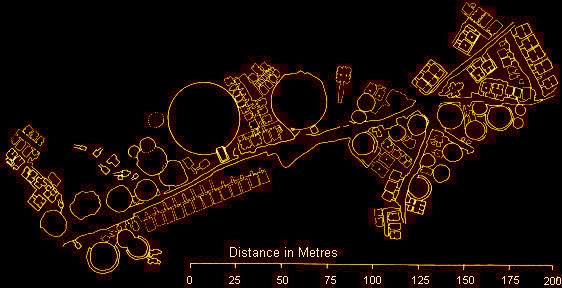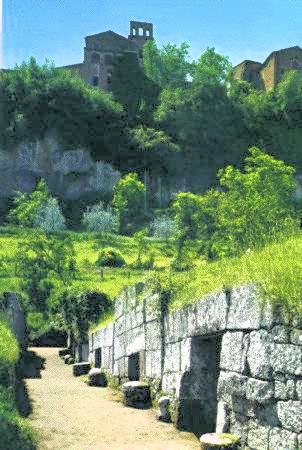The Development of Tombs within Tumuli
By Thanchvil Cilnei
The development of the tomb within a tumulus can best be seen in Cerveteri. A good example is the tumulus II in the Banditaccia Necropolis, where four burial chambers successively have been cut out in an axial position:
the Tomba della Capanna:
Built in the 7th century B.C.. It reminds of a primitive hut. Behind the "dromos" and burial chamber is a round niche, probably reminiscent of the fire place in pre- and protohistoric huts.
the Tomba dei Dolii
the Tomba dei letti e sarcofaghi:
built in the 6th century B.C.; on either side of the "dromos" there are two burial chambers, symmetrically laid out.
the Tomba dei vasi greci:
built in the 6th/5th century B.C.; this is the so called classical type of tomb. It consists of an "atrium" with stone death beds (and some stone chairs as well) and three burial chambers. This type of tomb probably imitates the Etruscan wooden house. In the cella a man is lying to the left and a woman to the right ( on a deathbed with frontispices (so called "frontons").

the biggest circle in the middle, to the north of the Via Sepolcrale Principale, is the tumulus II.
The Tomba dei Capitelli has columns with Aeolian capitels which is preferred by the Etruscans until the 1st century B.C.(1). According to research in the 1970's, the orientation of the oldest Etruscan tombs is to the West, where the Etruscans imagined the underworld to be.
In Orvieto, the necropolis Crocefisso del Tufo develops in the period 600-550 v.C. This necropolis has a rectangular street plan. The tombs are built align next to eachother. Above the entrance of each tomb the name of the first deceased who was buried inside has been inscripted (for example: mi................: "I (i.e. the tomb) belong to......"

an align row of tombs in the Necropoli Crocefisso del Tufo
NOTE
(1)Ciasca, A., Il capitello detto eolico, Roma, 1962.